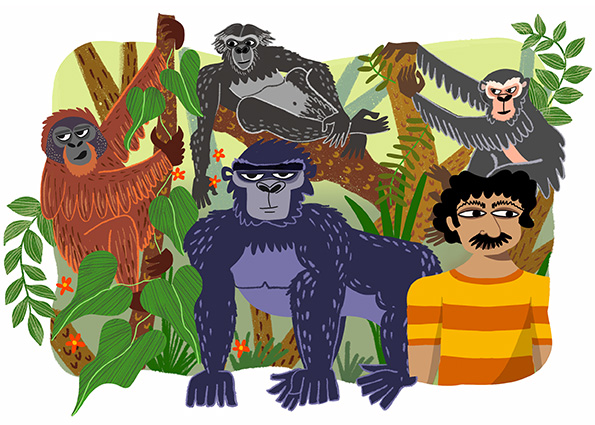In June 2015, I went to Ecuador for seven months, to study hummingbirds. The place I worked in, at an elevation of 3000m, was called El Gullan (pronounced el guyaan), after a flowering plant found in that area.
For the first two months I saw rainbows almost every day. El Gullan is on top of a plateau, with a view of a neverending valley. The vegetation is mostly scrub, rather than dense tropical forest, as you might imagine in Ecuador. A river trickled past, almost dry because it was an El Nino year and the rains were really whacky. There was lots of wind.
On a typical day, my field assistants and I would wake up at 4:30 – 5:00 in the morning, have a little coffee and something to eat and set out to open the mist nets, long lines of very thin nets, strung between poles. So thin are they that birds do not see them, and flying through, get caught. Every 20 minutes one of us would go see if any birds were in the nets. Other birds were simply released, but if a hummingbird was caught we would take it out, put a metal ring with a unique ID number on its leg, measure the length of its wing, leg and bill, and take photos. Sometimes we would collect its pee for analysis and let it go!
We would keep the nets open until around 10.30. By then the birds would be having some down time, and we were able to take some rest too. Our afternoons largely centred around delicious food. Breakfasts of scrambled eggs, omelettes, bread, cereal and juice. Then some time to enter our data onto a computer, discuss our work and read journal papers, before lunch. With a multinational team, lunches could be as colourful and varied as the hummingbirds. Sometimes I would make something Indian – perhaps a sabji with local vegetables, one guy loved to cook Chinese stir fry, or we would have Ecuadorian food, which is typically rice and beans, sometimes with meat. And whatever the food
we’d always have local fruit juice to drink. It’s a very Ecuadorian thing to have juice with every meal. Sometimes tomato de arbole – a ‘tree tomato’, sometimes maracuya, sometimes granadia, all fruits I had never eaten before.
After lunch we would have some time to laze in the sun. Daily temperatures ranged from 0° – 40° C! We would sit outside and bask like lizards on the grass or a bench. Then from 4:00 – 6:30 in the evening we would go out again, hoping to catch a single hummingbird for a ‘torpor experiment’. Hummingbirds are able to go into torpor, a state where they shut off their metabolism and lower their body temperature, to get through a period when they are not feeding. We are usually taught that some animals like reptiles are cold-blooded and others like mammals and birds are warm-blooded. These hummingbirds can be both. We wanted to measure how much energy the bird uses during this torpor period. The night was split into two shifts and somebody would check the bird every hour. We found that almost all species of hummingbird use torpor to save energy at night. The longer a hummingbird uses torpor for, the more energy it saves. We also discovered that rather than just being asleep or being in torpor (which are different things), they can also do all kinds of things in between. Hummingbirds are very flexible in how they use their energy!
What a contrast my life in Ecuador was from my life back in my university in the US. In Stony Brook, I wake up by 9:00am, go to the lab by 10:00am, stay until about 7:00 or 8:00pm, head home and am asleep by midnight. All day, I sit at a computer crunching numbers, writing reports, reading papers and meeting people. My room at the university doesn’t even have a window so I have no idea if it is sunny or cloudy, day or night!
I do what I do to understand how animals interact with their environment, and specifically to see how hummingbirds manage their energy needs. During the day, they get energy from the food they eat. But if they do not eat for about two hours, they can die. So they need to be very careful about how they use their energy. Flying and hovering uses up energy really fast, so to do this they need to eat a lot. At night, meanwhile, they can use torpor, to save enough energy to go and find more food in the morning. We are learning that hummingbirds have some really interesting strategies to balance their energetic needs. This has wider implications, because hummingbirds are important pollinators of plants, so understanding how they survive in different environments will help us to predict how they, and their
food plants, will fare should the environment change.
Fun facts
Unlike most other birds that just poop, hummingbirds pee. A LOT. They need to do this because they drink so much
nectar, or sugar water from flowers 2 to3 times their weight every day.
Hummingbirds use up energy so quickly that if an average human used energy as fast as they do, the human would need to eat 600 packets of potato chips a day to survive (when they’would normally need about 15).
Hummingbirds are the only birds in the world that can fly backwards, in addition to flying forwards and hovering in one place. Their wings are structured very differently from other birds, allowing them to hover by moving them in a figure-8 pattern.
Hummingbird wings can beat as fast as 80 times a second. Their hearts can beat more than 1000 times a minute. Your heart normally beats about 70 times a minute.
Time must seem very different to hummingbirds, compared to us. Their bodies (especially their heart, wings, and lungs) work so fast that their brains have to send signals for their wings to move backwards when the wings are only just starting to move forwards.





